Kiowa names calendar contest winners


















 BY CHANCY J. GATLIN-ANDERSON SPECIAL TO COLORADO COMMUNITY MEDIA
BY CHANCY J. GATLIN-ANDERSON SPECIAL TO COLORADO COMMUNITY MEDIA
e Town of Kiowa recently announced the winners of its second annual calendar photo contest. Photos were submitted of

 BY CHANCY J. GATLIN-ANDERSON SPECIAL TO COLORADO COMMUNITY MEDIA
BY CHANCY J. GATLIN-ANDERSON SPECIAL TO COLORADO COMMUNITY MEDIA









Extreme northwest Elbert County will be seeing commercial development at the intersection of Delbert and Singing Hills Roads. is will be the rst signi cant commercial development the area has seen for several decades.
Trevey Commercial Real Estate, the largest commercial real estate brokerage company in Elbert County and the surrounding areas, recently announced the sale of 8.25 acres located at 60 County Road 166. e property was sold by Anthony E. Breglio to CB Independence Holding Company for future development for commercial and retail businesses. Breglio was represented by Mitch Trevey. e parcel is meant to serve the immediate area and the newly developed Independence community.
As part of the development plan for the new Independence community, Delbert Road is planned to extend south from Singing Hills to Hilltop Road. is extension will bring vitality to this corner property and improve access and transportation connectivity for the northwest Elbert County area.
ough no plans are currently set as to what businesses will go into the space, Mitch Trevey of Trevey Commercial Real Estate gave his thoughts on what he thinks would work best for the land.

FROM PAGE 1
landscapes, animals and notable structures around Kiowa, highlighting its rural beauty. e contest is organized by Kimberly Boyd, the town administrator.



e 2023 calendar photo winners are:

First place (cover) — Susan Sewald




ird place (February) — Amanda







FROM


Calendar photos were chosen for each month. e other selected photographers are:

Bonnie Inga (March)
Susan Sewald (April)
Kelly Waldrop (May)
Susan Sewald (June)
Amanda Kelley (July)
Cara Fisher Marcum (August)
Claudia B. (September)
Heather Juenemann (October)
Susan Sewald (November)
Susan Sewald provided the photo for June, showing the Kiowa water tower.

“I was so excited to give the photos over to the judges for consideration and selection this year,” said Boyd. “ ere were so many entries and they were all really good. at made the selections this year much more challenging. We love to see the love our citizens have for Kiowa, all its beauty, and how they display it through their eyes.”
Local resident and Kiowa Schools librarian Susan Sewald had four photos chosen for the 2023 Town of Kiowa Calendar, along with the coveted cover photo spot. Sewald has been photographing various aspects of her life for the past 30 years, taking on more projects as her skills evolved.




Currently Sewald works with the Elbert County Fair as the o cial photographer. She also takes professional photos for aspects of the Elizabeth Stampede Rodeo, including their royalty and the Stampede to Read program. She also takes senior portraits for local high school students.

“I began taking pictures when my 31-year-old son was a baby. I would take him to get portraits done and he would just cry. So my husband got me an old SLC lm camera and I began doing them myself,” said Sewald in an interview from Jan. 9.
“If I could do whatever I wanted, I would just go places and take pictures every day. I don’t get around like I used to, so I grab pictures where I can.”
e photo chosen as the cover for the 2023 Kiowa Calendar is of Sewald’s 26-year-old mare, Darla. e photo was taken in the summer of 2022 as the sun owers were blooming in the pasture at Sewald’s home.
“She was my daughter’s royalty, 4-H, and rodeo horse. She has been with us since she was 10 years old,” commented Sewald. “She will live out her days in our pasture, which just happened to be lled with sun owers this summer. She has quite a personality.”

To purchase a calendar, please visit the Kiowa Town Hall or Patty Ann’s Cafe. ey will be available for $15 while supplies last. All money raised from the calendars goes toward funding future Town of Kiowa events.

e Town of Kiowa is currently taking submissions for the 2024 Kiowa Calendar Contest. ey are looking for striking images that depict life in Kiowa. Photos can include natural landscapes, wildlife, events, facilities, businesses, architecture, weather or local Kiowa residents. To submit photos, please email them to kiowa@townofkiowa. com by December 2023.

The Strive to Thrive Resource Fair will be held on Tuesday, Jan. 31 from 4-6 p.m. at the Calvary Chapel, 1100 Caprice Drive in Castle Rock. Enjoy a free hot meal and access valuable resources from more than 20 different organizations. Individuals and families are welcome to attend. For more information, visit douglas.co.us and search for Strive to Thrive.

Visit douglascotax.com to view parcel details, prior year payment history, pay taxes and more. Still have questions? Visit douglas.co.us/treasurer for additional information.





Douglas County residents may dispose of unwanted electronics free of charge at Techno Rescue, 3251 Lewiston St. in Aurora. Drop off weekdays from 8 a.m. to 4:30 p.m., and occasional Saturdays from 10 a.m. to 2 p.m. Proof of residency is required. For a list of acceptable items, Saturday drop-off dates and more, visit douglas.co.us and search for Electronics Recycling.
If you’re going through a difficult time, resolve to stay connected, stay active, and be kind to yourself. Check in regularly with friends and family. To learn more, visit letstalkco.org or hablemosco.org

Submit artwork entries by Feb. 7 to the Douglas County Art Encounters public art program, douglascountyartencounters2023-2024.artcall.org/ Visit artencounters.douglas.co.us for more information.

Our commitment to open and transparent government includes online posting of information about public meetings at which the business of government is conducted. To view public meeting agendas, participate in-person or remotely, or watch select meetings via live stream, visit douglas.co.us and search for Business Meetings/Public Hearings.
Eat out, use child care or have a septic tank?
Did you know the Douglas County Health Department helps keep our restaurants, grocery stores, childcare centers, and septic systems safe? Environmental Health focuses on preventing foodborne illness, preventing the spread of communicable diseases, and mitigating other environmental conditions. Visit douglas.co.us and search Health Department
Visit douglas.co.us
Are you a sculptor with a desire to see your work on public display?FROM PAGE 4 Kelly Waldrop provided the photo for May showing two goats in a field. Claudia B. provided the photo for September of a dog and deer exchanging stares. PHOTO COURTESY OF TOWN OF KIOWA Rachel Powell’s photo of a cow took second place and the January spot in the second annual Town of Kiowa Calendar Contest.











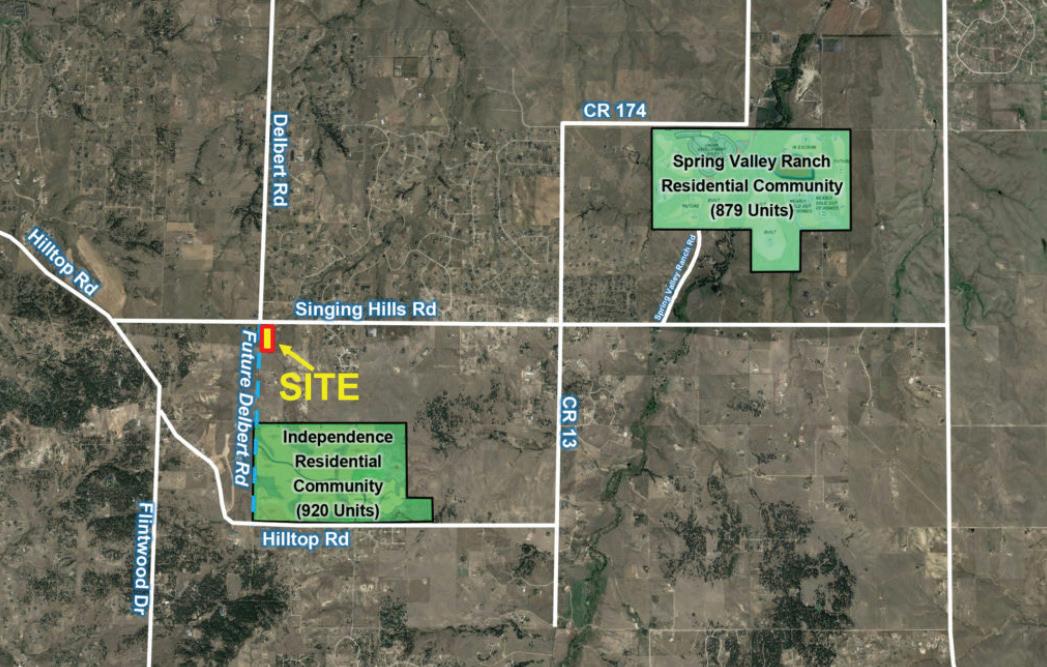
as well,” said Trevey. “First there will need to be road improvement and more rooftops. It’s a really good intersection. It will eventually need full-blown tra c lighting.”
Trevey anticipates that the de-



velopment will not begin for three to four years. “It’s not going to see commercial development without water and sewer,” said Trevey. “Ultimately it’s going to need lines that run back to Independence.”


For questions about the recent sale, Trevey Commercial can be contacted by phone at 303-8411400 or by email at info@trevey. com.

Recent increases in precipitation have brought much of Colorado out of drought and led to a solid start for winter snowpack in the mountains. Meteorologists are hopeful this could lead to a successful wet season, and even ease drought conditions this summer — but they aren’t making any calls just yet.
e latest U.S. Drought Monitor report indicated that 40% of Colorado was o cially drought-free, a signicant improvement from 0% this time last year. 9News meteorologist Chris Bianchi said the improvement was more than welcome.
“We’re not looking at just a blip in terms of drought impact,” Bianchi said. “ is is a substantial improvement.”
Heavy snow, mostly west of the Continental Divide, has helped in recent weeks, Bianchi said, but the entire state hasn’t been covered by snow. Still, Colorado is in a much better position overall, he said.
At the end of December, drought conditions were logged in about 86% of the state. e week of Jan. 3, most of the eastern plains still was dry, with severe or extreme conditions recorded along the state border.
As of Wednesday, statewide snowpack is at 127% of the median level and well above average in all
river basins except the Arkansas and Upper Rio Grande, according to the Natural Resources and Conservation Service’s weekly Snow Survey. Colorado State Climatologist Russ
Schumacher said these conditions have him cautiously optimistic.
“ e mountain snowpack in the winter is critical, because that’s our big natural reservoir of water serving both Colorado and the downstream states,” Schumacher said. “At least at this point in the snow accumulation, the numbers all look really good.”

ere’s also reason to be hopeful for good runo from the mountains in the spring, he said. After a wet summer in 2022, especially in the high country, Colorado entered the winter with better-hydrated soil than the past several years, according to Schumacher. is means that more snowmelt will make it to the rivers instead of being absorbed by the ground.
Schumacher is still waiting to see what the rest of winter has in store. When it comes to predicting drought conditions later in the year, precipitation levels this early aren’t the best indicators, he said. Experts will know much more by April, when total snowpack accumulation is clearer and they can predict water levels in the rivers more accurately. For now, he said, the winter is at least o to a promising start.
Bianchi is also waiting to see what the coming months bring. e heart of Colorado’s wet season, from late February to the start of spring, will have a much greater impact on drought conditions and wild re risk for the rest of the year, he said. ese early-season precipitation levels are not a de nitive sign, especially not for communities on the Front Range, he said.
“ is would be like the Broncos being at 14-nothing at halftime,” Bianchi said. “A great start, zero qualms about it. e problem is, it’s still only halftime.”
Dr. Benjamin Hatchett, a hydrometeorologist with the Nevadabased Desert Research Institute, said it was very encouraging to see areas
with more severe drought classi cation improve on the Drought Monitor, even if they didn’t lose classi cation entirely. He’s also glad to see the Rocky Mountains with less drought, since their runo sustains so many downstream communities in the western U.S.
However, for a drought-stricken state like Colorado to recover substantially and replenish local reservoirs, consistent improvement in precipitation over the long term has to happen, Hatchett said. Otherwise, in the big picture, nothing will change.
“To get out of those problems, we’re going to really need not just one year, but back-to-back, probably three or four years of really good winters,” he said.
e likelihood of consistently exceptional precipitation over the long term is low, he admitted. In the short term, though, this weather certainly isn’t bad news. Coloradans can expect storms to continue feeding the snowpack over the next 10 days or so, according to Hatchett. en things look like they may dry out a bit. And for the rest of the winter, he said, forecasting models are much less accurate — in other words, only time will tell.
But Colorado is in a good spot. Even if things dry out more than expected in the coming months, Hatchett said, the state’s head start on snowpack accumulation will be an important advantage.
“We’ve built up a bit of a bu er right now. at’s good,” he said. “We’ve got some snow in the bank.”
is story is from e Colorado Sun, a journalist-owned news outlet based in Denver and covering the state. For more, and to support e Colorado Sun, visit coloradosun.com.
e Colorado Sun is a partner in the Colorado News Conservancy, owner of Colorado Community Media.





















































































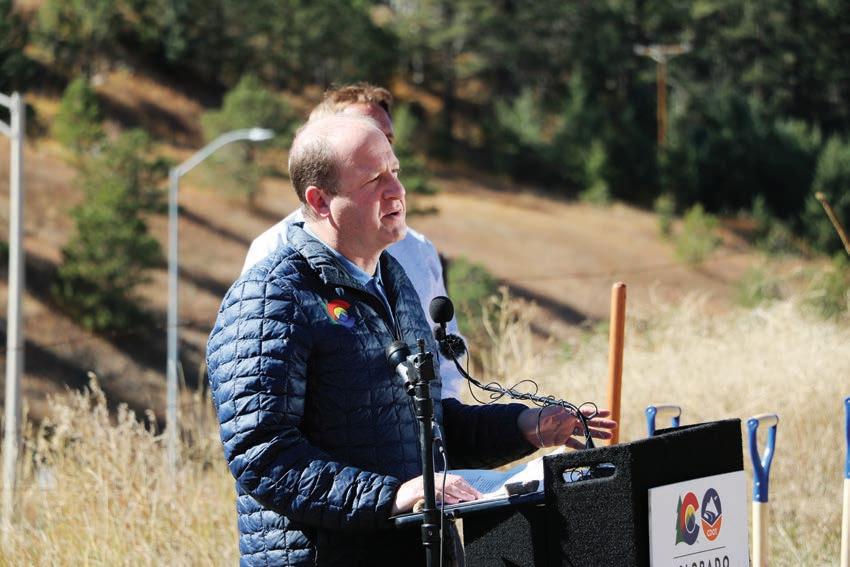



 BY JESSE PAUL THE COLORADO SUN
BY JESSE PAUL THE COLORADO SUN
Gov. Jared Polis wants state lawmakers to deliver an additional $200 million in property tax relief over the next two years, bringing the total respite o ered by the legislature over that period to $900 million, as Democrats and Republicans debate a long-term solution to rising tax bills resulting from skyrocketing property values across Colorado.
If the legislature, which begins its 2023 lawmaking term Monday, approves the expanded relief, it will mark the third time in as many years state lawmakers slap a BandAid on the problem that is Colorado’s property tax situation, which has big rami cations for schools and local government entities funded by property tax revenue.
A long-term solution palatable to many people and groups involved in the discussions, however, remains elusive, which is why Polis and the General Assembly keep o ering temporary xes.

Polis made the additional relief request in his supplemental budget request last week. He didn’t say how the relief should be o ered, however, explaining that he will mostly leave that to the legislature.
If the legislature approves Polis’ request — and that’s a big “if” — it


will be the second time in two years state lawmakers will have limited the increase in Coloradans’ property tax bills for 2023 and 2024 in anticipation of a jump in property tax assessments. e General Assembly in 2022 cut $700 million from Coloradans’ expected property tax bills for those years.
“Assessments had a greater increase than any of us thought — 26.5%,” Polis said last week during a news conference. “We’re happy with the relief we provided. Assessments came in higher, so it warrants additional relief.”
e governor wants the legislature to use $200 million of its discretionary general fund money to back ll tax revenue lost to school districts and other local government entities. State lawmakers may be reticent to hand over the cash, however, given the in ationary budget crunch they face this year.
Senate President Steve Fenberg, D-Boulder, told e Colorado Sun he thinks lawmakers “are open to doing general fund investments” to blunt the impact of rising assessment rates.
“I think it will happen, though,
simultaneously with a longer-term (property tax) solution rather than having to do this every year,” Fenberg said. “I think the bigger question is what ways can we solve the structural problem and get property taxes on the more sustainable path for residences as well as for commercial properties.”

Fenberg was referencing a replacement for the Gallagher Amendment, which Colorado voters stripped from the state constitution in 2020. Gallagher prevented residential property tax bills from quickly rising by shifting the tax burden to commercial property owners through assessment rates, which help determine how much property owners pay in taxes. But Gallagher collided with another constitutional amendment, the Taxpayer’s Bill of Rights, in a way that hamstrung the government entities that rely on property tax revenue.
“In my opinion, and I’ve been watching this from the outside for the last number of years, when the good voters of the state of Colorado decided to repeal the Gallagher Amendment there were a couple of things they didn’t realize,” said incoming state Rep. Lisa Frizell, a Castle Rock Republican and a former Douglas County assessor. “One was that they laid the establishment of assessment rates solely (at the feet of) the legislature, which was a bit concerning.”



















Platt




About two weeks ago I was thinking about writing a column about organized sports and our youth. en, I watched the NFL game between the Bu alo Bills and Cincinnati Bengals and decided it was a good idea with a little more power to it.
EDITOR’S COLUMN
Sometimes sports gets a bad rap. No, not everyone is made to be an athlete. But no matter where my sons end up going in their futures, I do not doubt for a second the skills, abilities and interactions will help shape whatever they do.
Before getting to my son’s own experiences, I want to start with what happened in Cincinnati when Buffalo’s defensive back Damar Hamlin su ered a freak accident while tackling receiver Tee Higgins. I am a major football fan so I rarely miss a game. Not surprisingly, I was watching the game live. I watched Hamlin pop up right after the tackle and then fall to the ground.
Thelma GrimesBased on player reactions and tears I knew it was far more than the concussion our minds usually go to. What came after the life-saving measures on the eld were why I still believe in humanity and organized sports.
You had two teams know they could not go on and play a game because a player’s life was more important. You had a nation, love or hate football, rooting for this man to survive. You had well wishes, strong support and a toy drive receive millions in donations in Hamlin’s name.
When you play sports, you get another family. ey become part of your everyday lives and you play for and support each other.
My 9-year-old started playing his rst year of competitive hockey this year. He loves the sport and shows a lot of passion for learning the game and getting better.
When he rst started, his team, in the 10-and-under Arapahoe Warriors league, was hard to watch. ey are learning the sport and we were losing a lot. We as parents were in the stands every game being supportive but worried when we were losing by six or more goals.
Fast forward a few months and this team is now winning regularly. ey are supporting each other, pushing each other and I see the improvement in my son’s play and that of others on the team. He is proud of what they are doing every week.
Having him also be proud of himself is nice to see. He is making friends, he is learning from a wonderful coaching sta , and he is gaining principles and skills that will carry him beyond hockey in the future.
As much of a bad rap as sports teams can get — I can never replace the friendships my son is earning. I can’t beat the support and friendships I am making with the parents in the stands. I know all of them care about my son and cheer him on in each game.
With sports, too, comes emotion. Hamlin is a great example. On Jan. 8, every team in the NFL wore shirts in support of Hamlin. ey showed vulnerability in talking about the rare incident that caused him to go into cardiac arrest suddenly.
Love, support and growth are what we all want to have in our lives. For Hamlin, NFL athletes and my son as he takes this journey forward — I do love the often overlooked positives of joining a sports program.
elma Grimes is the south metro editor for Colorado Community Media.

LINDA
lshapley@coloradocommunitymedia.com
As a part of his workout, he included time standing on in atable balance discs in between sets of weightlifting. His goal was to maintain his balance on the disc for 45 seconds while standing on each leg. Sometimes he stayed in balance for more than 45 seconds, and other times he lost his balance quickly. As I watched his routine, I became curious. When we both nished our workout, I approached him to ask about his workout and goals for the balance disc.
He shared with me that he was using the balance disc for several reasons. He wanted to make sure he was working on the little muscles around his ankles and knees. And he also felt like it improved his balance when walking, hiking, gol ng and skiing. en I asked him about why he was able to remain standing on one leg on the balance disc sometimes for a minute or more, and other times he lost his balance early or in just 10 or 15 seconds.
His response didn’t shock me. He shared that when he was able to maintain his focus on staying in balance on the disc, he could stay on for longer periods of time. He always stood in front of a mirror in the gym and would center his eyes on his chest in the re ection. e times when he achieved
LINDSAY
ERIN
AUDREY
ERIN
the greatest success were when he remained focused on his position. However, he said that when he lost his balance early it was because he allowed his mind to drift onto other things going on in his life.
How many of us lose our balance in life when we allow ourselves to become distracted? We all want balance, yet too often we wind up being our own worst enemy as we spread ourselves too thin. When we do this, we invite distraction into our lives, knocking us o balance and out of harmony. And when we nd ourselves feeling like we have lost it and balance is nowhere to be found, we should remember the lesson from my friend in the gym and reacquire our focus.
e rst thing we need to do is to understand our priorities and where we want balance and harmony in our lives. Once we are completely aware of what is truly important to us, then we can align our expectations and boundaries so that we don’t give way to the distractions that pop up. And most importantly, after establishing our priorities and setting our boundaries, is that we remain focused on the people, activities and things in life that bring us the greatest joy and satisfaction.
Let’s face it, distractions come at us all day long, life happens. ey come in the form of calls, texts, emails, news, social media, unexpected circumstances and situations. We can never completely avoid being sidetracked,
NORTON,& Guest Commentaries
Columnist opinions are not necessarily those of the Elbert County News.


We welcome letters to the editor. Please include your full name, address and the best number to reach you by telephone.
Email letters to letters@coloradocommunitymedia.com

Deadline Wed. for the following week’s paper.
ELBERT COUNTY NEWS (USPS 171-100)
A legal newspaper of general circulation in Elizabeth, Colorado, the Elbert County News is published weekly on Thursday by Colorado Community Media, 750 W. Hampden Ave., Suite 225, Englewood, CO 80110.








PERIODICALS POSTAGE PAID AT ENGLEWOOD, COLORADO and additional mailing o ces.
POSTMASTER: Send address change to: Elbert County News, 750 W. Hampden Ave., Suite 225, Englewood, CO 80110




















As we usher in 2023, we say “good riddance” to the market mayhem of 2022.

calendar year.
“A year to forget” is how one of our research partners dubbed 2022. Despite a modest rebound for many asset classes during the fourth quarter, 2022 turned out to be one of the worst years on record for multi-asset portfolios. ere were very few investment categories that posted positive returns for the full year. According to Ned Davis Research, it was the rst time on record that both the S&P 500 Index and the Bloomberg U.S. Aggregate Bond Index lost more than 10 percent in a
FROM PAGE 12
but we can minimize our chances of being distracted by knowing and owning our priorities and remaining focused on those.
Not taking the time to think through and commit to what is most important to us is like trying to drive somewhere that we have never been without GPS or a map. And as the old quote by Lewis Carroll goes, “If
is means there was nowhere to hide. Both conservative and aggressive investors likely lost money. Some bond funds, normally considered the safer haven in a portfolio, were down double digits for the year as interest rates pushed higher. e good news is you might be earning a little more on your bond or money market yields.
Brett Lapierre, CFA cites stubbornly high in ation and aggressive rate hikes from most of the world’s central banks as two main reasons for the di cult year and weak performance across the nancial markets. e Russia/Ukraine con ict also added to the volatility, although it helped energy-related assets post positive results for the quarter and year. China shutting down for much of the year hurt exports and supply chains.
you don’t know where you are going, any road will get you there.”
Where are we missing our balance? Is it at home? At work? In our relationships? If we could improve the harmony in our lives, where would it create the greatest impact? For me, my balance comes when I remain focused on the ve Fs in life: my faith, family, friends, tness and nances, and in that order. And now thanks to my new friend from the gym, I can add the sixth F, focus.
Are you nding balance in the most important areas of your life?




The Colorado Sun is a journalist-owned, award-winning news outlet that strives to cover all of Colorado so that our state — our community — can better understand itself.
In this way, The Sun contributes to a more vibrant, informed and whole Colorado.
The Sun, launched in 2018, is committed to fact-based, in-depth and nonpartisan journalism. It covers everything
Colorado Community Media welcomes letters to the editor. Please note the following rules:
• Email your letter to letters@coloradocommunitymedia.com. Do not send via postal mail. Put the words “letter to the editor” in the email subject line.
• Submit your letter by 5 p.m. on Wednesday in order to have it considered for publication in the following week’s newspaper.
• Letters must be no longer than 400 words.
• Letters should be exclusively submitted to Colorado Community Media and should not submitted to other outlets or previously posted on websites or social media. Submitted letters become the property of CCM and should not be republished elsewhere.
• Letters advocating for a political candidate should focus on that candidate’s qualifications for o ce. We cannot publish letters that contain unverified negative information about a candidate’s opponent. Letters advocating for or against a political candidate or ballot issue will not be published within 12 days of an election.
from politics and culture to the outdoor industry and education.
Now, The Colorado Sun co-owns this and other Colorado Community Media newspapers as a partner in the Colorado News Conservancy. The Sun is CCM’s partner for statewide news.

For Colorado Sun stories, opinions and more, and to support The Sun’s misssion as a member or subscriber, visit coloradosun.com.
“ e U.S. economy showed more signs of slowing despite rebounding during the third quarter and likely seeing positive gains for the fourth quarter. e labor market remained one of the bright spots in the U.S. economy as the year ended, but the risk of a recession unfolding over the next 12 months remains elevated in my view,” says Lapierre.
During the fourth quarter, markets got a little reprieve with in ation data further improving and the Federal Reserve slowing down its rate hiking campaign. But the Fed has not quite nished raising rates yet. Nevertheless, interest rates were a little steadier during the fourth quarter than earlier in the year with the 2-year U.S. Treasury yield nishing at 4.41%, up 19 basis points on the quarter, while the 10-year U.S. Treasury yield nished at 3.88%, up 5 basis points on the quarter. For the
Would a little more focus and less distractions help you nd your balance? I would love to hear your story at gotonorton@gmail.com and when we can maximize balance by minimizing distractions, it really will be a better than good life.
year, yields were up 363 basis points and 225 basis points, respectively. is is signi cant movement in the xed income world where many retirees are invested. Designing custom portfolios this year will be crucial for investors, especially if you were able to tax-loss harvest last year. You have a clean slate to begin a new strategy in a new year that ts with your nancial plan. Don’t wait to get in front of your advisor while the year is young.
Brett Lapierre, CFA, is Senior Investment Strategist for Mariner Wealth Advisors
Patricia Kummer has been a certied nancial planner professional and a duciary for over 35 years and is Managing Director for Mariner Wealth Advisors, an SEC Registered Investment Adviser.
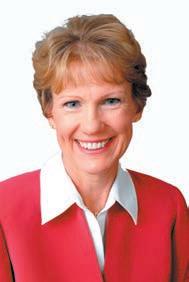
Michael Norton is an author, a personal and professional coach, consultant, trainer, encourager and motivator of individuals and businesses, working with organizations and associations across multiple industries.
• Publication of any given letter is at our discretion. Letters are published as space is available.



• We will edit letters for clarity, grammar, punctuation and length and write headlines (titles) for letters at our discretion.
• Please don’t send us more than one letter per month. First priority for publication will be given to writers who have not submitted letters to us recently.
• Submit your letter in a Word document or in the body of an email. No PDFs or Google Docs, please.
• Include your full name, address and phone number. We will publish only your name and city or town of residence, but all of the information requested is needed for us to verify you are who you say you are.
• Letters will be considered only from people living in Colorado Community Media’s circulation area in Adams, Arapahoe, Clear Creek, Denver, Douglas, Elbert, Je erson and Weld counties.
• Do not use all caps, italics or bold text.
• Keep it polite: No name calling or “mudslinging.”




For the past 20 years, talk of addressing mental health issues within the health care industry circled around without much emphasis. at’s beginning to change, and it’s starting with the ne arts.

At the Colorado Resiliency Arts Lab at the University of Colorado Anschutz Medical Campus, a team of doctors, therapists and literary scholars are doing just that: exploring how the ne arts can help nurses, doctors, surgeons and other healthcare workers heal from trauma.


e team found that creative arts therapy not only decreases anxiety, feelings of burnout and depression, but also helps keep medical workers in their eld.

e study, published in the American Journal of Medicine in 2022 found that anxiety, depression, total PTSD and emotional exhaustion measurement scores decreased by 27.8%, 35.5%, 25.8% and 11.6%, respectively.




Katherine Reed, an art therapist for the program, said that 12% saw a reduction in the desire to leave the profession.
“It’s amazing in how basic it really is, and yet it’s creating these incredible results,” Reed said.











































Dr. Marc Moss, a doctor who is part of the CORAL team, said the program received funding from the National Endowment for the Arts in 2019 to prove the value of the ne arts, after the National Endowment for the Arts requested proposals to show Congress that art was worth the money spent.
“It’s easy to say, ‘Wow, it’s great having a symphony’ or ‘It’s great having parks and etc.,’ but what’s the value of that?’” Moss said.
“ ey wanted to have more scienti c evidence.”








From the results of the study, CORAL did
































nication. Egyptian Hieroglyphics morphed into language.
Over the course of her 20-year career as an art therapist, Reed said she has a front-row seat to the limitations of language on expression, especially in children. Children — and adults — may lack the words or rhetoric to describe their experiences or their feelings, and music, painting, drama and other forms of art can act as a backdoor to expressing those feelings.

“(Children) can show you with sound and music what it feels like in their brain to remember the impact,” Reed said. “It’s a way of communicating that bypasses language. When we talk, we’re constantly ltering our words.”
It deepens the healing and clients don’t need to know how to draw, play an instrument or act out. It’s about interpreting your own symbols, song lyrics and paint color choices to nd meaning.

Witnessing trauma like death,

injury, illness and medical ethical dilemmas are all themes that come up in the workshops. In medical school, classes don’t necessarily exist to teach students how to deal with it.
“You get into real-life medicine and suddenly (there are) personalities, narratives, stories and family members you’re not necessarily equipped to manage. You know how to transplant that heart, but do you know how to manage the mother’s panic or the father’s anger?” Reed said.
Another root cause can be the American healthcare system in general. Reed said doctors may need to see 20 patients in one day, which limits the time to actually talk with them since then they need to document those appointments. at leads to longer hours and less time with loved ones, making it
harder to nd a work-life balance.

A lack of emotional learning for healthcare workers also hints at a broader issue at hand in general. Many parallels exist between healthcare workers and students, who may not know how to express or manage their own feelings, Reed said.
rough art therapy and CORAL, healthcare workers can learn to manage those feelings. Not only for their own well-being, but also to be more successful in their day-to-day job.
A lack of those tools can lead to higher rates of turnover, and Moss said it makes the program all the more valuable.
“Turnover is expensive,” Moss said.

at piques interest in hospital
administrators. Less burnout and turnover of employees is coste ective. Moss said the COVID-19 pandemic ampli ed the need for mental health resources for hospitals and administrators are looking for ways to do that.
So much so that the Children’s Hospital agreed to start a program outside of the grant. Once the grant from the National Endowment for the Arts finishes its 10year period, not only does Moss think more programs will exist in Colorado, but also all across the country.
He sees a larger multicenter study occurring at multiple di erent hospitals in di erent cities to expand the evidence on the e ciency.

“If a pill had the results that CORAL has, every single person would be taking it because it’s a ordable and it works,” Reed said.
At Colorado Farm Bureau, we’ve worked for 103 years to protect what makes rural Colorado special. As a member you’re a part of a close knit community that protects rural Colorado and the agriculture industry. You’re part of a family.
Join the Farm Bureau Family today and help us grow a vibrant rural communities and strong local economies. You’ll have access to thousands in members-only benefits and like-minded farm and ranch families from across the state.
Become a member at www.ColoradoFarmBureau.com





PROPERTY
FROM
Frizell said the legislature keeps kicking the property tax problem down the road, but she admits it’s difficult to come up with a permanent fix.
“I don’t have a slam-dunk solution,” she said, adding that she expects home values to increase at a much larger clip than the 26.5% rate cited by Polis.
Polis agrees that a long-term replacement to Gallagher is needed. But neither he nor Democrats in the legislature have publicly offered any concrete solutions, and both chafed last year at ideas offered by conservatives, including permanent rate reductions and caps on property tax increases.
“We need some mechanism to prevent runaway property tax rates and also to address some of the injustices that Gallagher created, namely a commercial property rate that is several times higher than many other states,” Polis said. “What are we looking for? Some reductions in commercial property taxes — benefiting our small businesses, making our state more competitive, creating jobs — and then a mechanism to protect homeowners from being priced out of their homes.”
The legislature can — and may — punt on a long-term replacement for Gallagher until the 2024 lawmaking term since the relief it has passed lasts through next year.
Last year’s property tax fight was feisty and it ended with something akin to a hostage exchange in the basement of the Colorado Capitol as interest groups backed off their plans to ask voters to make broad changes to the property tax system. There was also a property tax debate at the Capitol in 2021.
Michael Fields, a conservative fiscal activist with the political nonprofit Advance Colorado Action, has been a key player in state property tax discussions. He said he’s waiting to see what the legislature comes up with this year before deciding whether to try to shape policy through a ballot measure. (A 2021 property tax ballot measure led by Fields that would have cut assessment rates for some types of property failed.)
Scott Wasserman, who leads the Bell Policy Center, a liberal fiscal policy nonprofit, is another key player in the property tax policy debate. He said he is working on proposals.
“This is just not a sustainable way to solve the problem,” he said of the year-after-year relief measures debated in the legislature. “It’s $200 million this year. How much is it going to be next year?”
Frizell is planning to introduce a bill this year that would prevent home values from being changed by county assessors in 2023, as planned, to prevent a big jump in Coloradans’ property tax bills. Instead, she proposes the state legislature increase home values last determined in 2021 by 5%, giving lawmakers time to come up with a long-term property tax solution before 2025, when home values are set to be evaluated by assessors once again.
“I don’t think throwing money
at it is always the solution,” Frizell said.
Additionally, Republicans plan to ask the legislature this year to approve the creation of a property tax task force to come up with a long-term fix.
Here’s what the legislature did in 2022 through the passage of Senate Bill 238 to reduce Coloradans’ rising property tax tab:
The residential assessment rate used to calculate how much a residential homeowner owes in property taxes in 2023 is reduced to 6.765% from 7.15%. Additionally, the first $15,000 in actual value of a residential property is waived as long as doing so doesn’t cause the assessed property value to fall below $1,000.
For commercial properties, the assessment rate in 2023 is reduced to 27.9% from 29%. Additionally, the first $30,000 in actual value of a commercial property is waived as long as doing so doesn’t cause the assessed property value to fall below $1,000.
Assessment rates are important because they are used to calculate how much someone owes in taxes. The rate is multiplied by a home’s market value, which is determined by a county assessor. What a property owner pays is then determined by the mill levy rate. A mill is a $1 payment on every $1,000 of assessed value. The 2023 reduction will mean that a residential property owner who owns a home worth $300,000 with a mill levy of 100 will pay about $1,900 versus $2,145. (The state has a good explainer on this here.)
In 2024, the rates will go up slightly. For single-family residential property owners, the assessment rate will be approximately 6.95%, down from 7.15%. For multifamily residential property, the rate will be 6.8%.
(Why approximately, you ask? The single-family residential property assessment rate will be set in 2024 at a level to be determined by the state property tax administrator to ensure that the state hits its $700 million property tax relief target for the 2023 and 2024 property tax years.)
For those who own commercial property used for agriculture and/ or to produce renewable energy, the 2024 assessment rate will be 26.4%, down from 29%.
The 2024 rates match a reduction approved for the 2021 and 2022 tax years under a measure passed by the legislature in 2021.
Finally, the legislature extended a change allowing senior citizens to defer all of the increases in their property taxes until they sell their homes while allowing everyone else to defer any increases over 4%.
It’s likely that if more property tax relief is approved by the legislature in 2023, as Polis hopes, it will simply be made by expanding the breaks offered by Senate Bill 238.

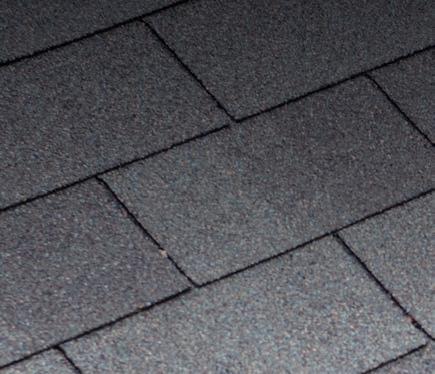



































































e Colorado legislature will debate a bill this year that would ask voters in November to waive their future Taxpayer’s Bill of Rights refunds and earmark the money, potentially billions of dollars each year, to public education.
e forthcoming measure, sponsored by state Rep. Cathy Kipp, a Fort Collins Democrat and former Poudre School District board member, and state Sen. Rachel Zenzinger, an Arvada Democrat who has worked as a teacher, is sure to face pushback from Republicans, who are erce defenders of TABOR refunds. ere could also possibly be opposition from some fellow Democrats, including Gov. Jared Polis, who would like to see the money spent elsewhere.
“We need to pay our teachers,” Kipp said. “We need to fund our schools. We do not fund our public schools adequately. TABOR is a part of that.”
TABOR requires voter approval for all tax increases in Colorado and it also caps government growth and spending, mandating that tax revenue collected in excess of the cap be refunded to taxpayers. In the case of state government, the legislature decides how the refunds are distributed. Last year, Coloradans were mailed checks of $750 or $1,500 after
the state collected more than $3 billion over what the cap allowed.
But TABOR also lets local governments and the state ask taxpayers to eliminate the cap so that they can keep the excess revenue. In 2019, voters rejected Proposition CC, which would have let the state keep TABOR surplus. e measure failed by 8 percentage points.
Since TABOR surplus can vary from year to year — in some years there may be no surplus at all — Kipp calls her bill a Band-Aid until Colorado comes up with a dedicated funding source for schools, which would likely be through a tax increase.
“ is is not long-term sustainable funding,” Kipp said. “But I joined the legislature so we could gure out how to properly fund our public schools. I am looking for solutions. And this is one of them — potentially.”
Zenzinger said the idea stems from a proposal from Great Education Colorado, a group that advocates for more funding for schools.
Kipp said that if a long-term, sustainable funding source for schools is identi ed, the legislature could vote in the future to repeal the TABOR surplus school funding mechanism.

e legislature is supposed to increase annual per pupil funding at the rate of in ation under Amendment 23, a measure passed by voters in 2000. But in the wake of the Great Recession, state lawmakers in 2010 adopted the budget stabilization fac-
Additionally, teacher pay has been a persistent area of complaint in Colorado, with districts recently struggling to attract and retain educators.
Republicans and conservative groups are already lining up against Kipp’s proposal.
State Sen. Barbara Kirkmeyer, a Brighton Republican, said the legislature should shift its funding priorities and send more money to schools rather than ask voters to waive their TABOR refunds.
“I think we should follow the Constitution and fund it like we’re supposed to,” she said, “not with TABOR refund dollars.”

Michael Fields, a conservative scal activist with the political nonpro t Advance Colorado Institute, said the legislature has already invested more money in schools.
“ e problem is that not enough of that money is going to teacher pay. We need better outcomes and more accountability with the billions of dollars we are already spending on education,” he said. “With the cost of living higher than ever, Colorado families want their TABOR refund checks.”
Meanwhile, Polis said in November that he wants a TABOR surplus to be used to drive down Colorado’s income tax rate. He supported Proposition CC in 2019, but since then hasn’t publicly advocated for the state to ask voters again to keep TABOR surplus. Since Kipp’s bill would be a referred measure, Polis’ signature on the measure wouldn’t be needed and thus he couldn’t veto it. It would only need a simple majority to pass, and Democrats control both the House and Senate by wide
as this week, will also likely be called














TABOR refunds last year ahead of the November election. Polis held multiple news conferences during which he enthusiastically publicized the checks Colorado sent to taxpayers.
Kipp even voted for a bill the legislature passed in 2022 facilitating the refunds and making them a at rate as opposed to being tied to income levels as prescribed in law.
e bill also prompted the state to pay out the checks in August and September rather than in April 2023, which is when they would normally be distributed.
“ at was a one-time, equitable distribution of the refund,” she said, highlighting how TABOR refund checks have generally been much smaller if they even happen at all. “People generally get very small amounts of money back. And what could we do with all that money if we put it together? We could do a lot of good things for public education. at’s what we’re trying to do.”
Kipp’s bill wouldn’t a ect the TABOR surplus used to reimburse local governments for any property tax exemptions claimed by local seniors and disabled veterans. It also wouldn’t touch the roughly $300 million in TABOR surplus set aside each year for a ordable housing by Proposition 123, which voters approved on Nov. 8.
is story is from e Colorado Sun, a journalist-owned news outlet based in Denver and covering the state. For more, and to support e Colorado Sun, visit coloradosun.com.

e Colorado Sun is a partner in the Colorado News Conservancy, owner of Colorado Community Media.


























































 BY JESSE PAUL, ELLIOTT WENZLER AND SANDRA FISH THE COLORADO SUN
BY JESSE PAUL, ELLIOTT WENZLER AND SANDRA FISH THE COLORADO SUN


Gov. Jared Polis provided a road map for how he plans to spend his next four years leading Colorado as he was sworn into o ce for his second term.
“When you listen to enough folks, you realize that in many ways people across our state are asking for some of the same things in di erent ways: practical solutions to the rising cost of living in every corner of our state, safe communities, good schools, a ordable access to health care, the opportunity to build a great life for yourself and your family and the freedom to forge your own path without the government telling you how to live your life,” Polis said in a speech delivered on the west steps of the Colorado Capitol.
He added: “I don’t think I’d be standing before you today if we hadn’t shown some real progress on delivering on di erent parts of this vision.”
Here are the top lines from the Democrat’s 2023 inaugural address:
1. “Throughout our first term, we may have crossed some big things o our to-do list, but that doesn’t mean the list in front of us today is any shorter than it was four years ago.”
Polis was busy during his rst term. He signed into law bills reimagining Colorado’s oil and gas regulations, providing universal kindergarten access and targeting high health care costs.
e governor is still working out what his agenda will be over the next four years — it wasn’t clear until after the Nov. 8 election that he would continue to have a Democratic legislature to work with — but his line about a long to-do list ahead suggests he plans to be as busy in the next four years as he was during the last four.
We know that a ordable housing, water management and conservation, and economic development are top of mind for Polis.

2. “Anything we can do, we must when it comes to helping you hold onto more of your hard-earned money.”


e governor and Democrats in the legislature started really prioritizing a ordability in Colorado during the 2022 legislative session. ey plan to continue making it a focus this
year, though it’s not so clear how.



In 2022, the legislature slashed and paused fees — several of them enacted by Polis and Democrats in prior years — and reshaped the tax code to try to lower Coloradans’ nancial burden. e General Assembly isn’t planning to continue the vast majority of the fee relief, instead focusing on what Senate President Steve Fenberg, D-Boulder, called “structural problems.”
A ordable housing will be a big focus.


“For many people in our state, life is too hard and too expensive,” Polis said. “We’re going to reduce housing costs across Colorado with options for every budget to a ord to live in communities where people work and want to live.”
e governor also promised “lower taxes, lower transportation costs, lower medical bills, lower business fees and, of course, lower housing costs.” He didn’t outline his detailed plans for accomplishing that hefty list of vows.
3. “We’re going to tackle crime head on, yes by holding criminals accountable, but also by preventing crime before it happens.”
is was one of the most interesting lines of the governor’s speech.
There are many criminal justice activists in the legislature now, including state Rep. Elisabeth Epps, D-Denver, who don’t want to see Colorado enact any new criminal penalties. Instead, they want to see more investment in behavioral health and drug treatment.
Polis wants those things, too, but he has also already called for the legislature this year to beef up Colorado’s car theft statutes to combat the rising number of stolen vehicles across the state.
Republicans in the legislature see tougher criminal
penalties as the sole solution to Colorado’s rising crime rates. Polis appears to be walking a line between the sides.
4. “We’re going to continue on our bold path toward making Colorado 100% renewableenergy by 2040.”
is is a promise Polis made during his rst gubernatorial campaign, in 2018.
e governor has said the state has already “locked in” 80% renewable energy by 2030. But what steps the legislature and the Polis administration will take to make the goal a reality remain unclear.
GOVERNOR
FROM









Liberal Democrats and Polis have clashed in recent years over policies aimed at reducing greenhouse gas emissions and mitigating climate change.


Polis also mentioned during his speech that Colorado has an “increasingly scarce water supply,” but he didn’t provide any speci c plans on how to address that fact.
5. “Nobody could have predicted all that these last four years would bring, the trials, the tribulations, the challenges.”






Polis’ rst term was marked by a string of tragedies and hurdles, the biggest of which was undoubtedly the COVID-19 pandemic. e pandemic began a little over a year after Polis took o ce, forcing him to lead the state through a oncein-a-century global disaster, which is still unfolding. e governor shut down schools and businesses, asked people not to leave their homes and had to abandon at least a year of policy proposals at the legislature as the state prepared for a sharp tax revenue decrease that never materialized.
Polis didn’t directly reference the pandemic and the upheaval it caused during his speech Tuesday, but it was clear that is what he was talking about.
Meanwhile, two tragedies hit close to the governor’s Boulder home during his rst term. In March 2021, 10 people were killed in a shooting at a King Soopers grocery store in the Table Mesa neighborhood. en, in December 2021, the Marshall re destroyed more than 1,000 homes in Superior and Louisville.

Just weeks after his reelection,


ve people were killed and at least 17 others were wounded in a mass shooting at Club Q, a gay nightclub in Colorado Springs.
e state has also contended with several other record-breaking wild res over the past few years, including the Cameron Peak, East Troublesome and Pine Gulch res. A total of 6,761 wild res burned more than 744,120 acres in Colorado in 2020 alone.
Addressing such emergencies over the past four years often distracted Polis and the legislature from their aspirations. Polis acknowledged Tuesday the future always holds uncertainty.
6. What the governor didn’t mention Abortion and gun control.
Democratic lawmakers this year are expected to introduce legislation tightening Colorado’s gun regulations, including by enacting a waiting period between when someone can purchase a rearm and access that weapon and by raising the age at which someone can purchase a ri e or shotgun to 21.
e legislature is also poised to expand who can petition a judge to order a temporary seizure of someone’s guns under what’s called the red ag law.
Some Democrats, including Epps, want to go even further by banning a host of semi-automatic weapons, a policy proposal the governor is likely to reject.
Class B CDL propane delivery truck driver for Spring Valley Gas, Elizabeth.


P/T & F/T positions; responsible for propane delivery and customer service.






HazMat/Tanker endorsement. Propane certification a plus. Insurance age requirement 26 with clean MVR. SVG is building a team, not just a job!
Starting salary based on experience & qualifications. Call 303-660-8810.








This is a part-time position, up to 30 hours per week. This is a great opportunity to work into a full-time assistant manager position. Starting pay ranges from $25.00 and up per hour, commensurate with experience and training. Applicants are required to have good skills in computer data entry, ten key, and the ability to use Word and other standard Microsoft applications. Applicants must also have good customer service skills and the ability to handle payments in a secure and accurate manner. Applicant must be bondable and qualified to receive Notary Public status in the State of Colorado. Please submit an application along with your resume for consideration. Resumes without a completed application will not be accepted. Submit your documents to Diana Miller, District Manager at dmiller_ ppwsd@comcast.net. You can also mail your documents to Perry Park Water and Sanitation District, 5676 Red Rock Drive, Larkspur, CO 80118. You can download an application and view the job description by visiting our website at www.ppwsd.org. Perry Park Water and Sanitation District is an Equal Opportunity Employer.
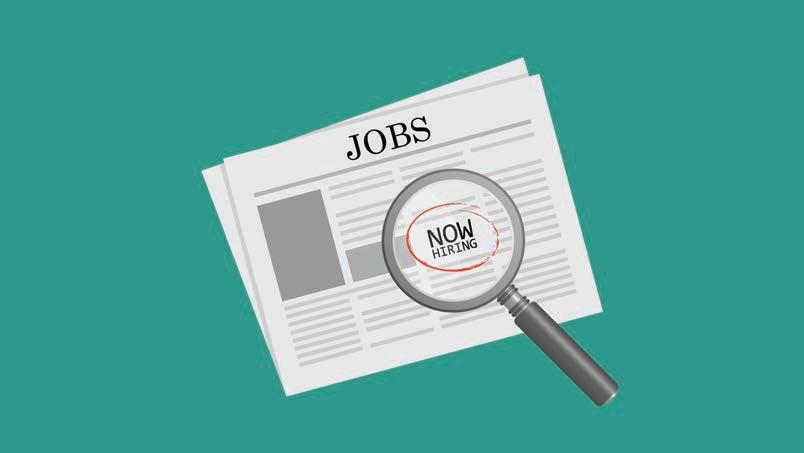



Attention Homeowners! If you have water damage and need cleanup services, call us! We’ll get in & work with your insurance agency to get your home repaired and your life back to normal ASAP! 855-7677031
Switch and save up to $250/yr on talk, text & data. No contract or hidden fees. Unlimited talk & text with flexible data plans. Premium nationwide coverage. 100% U.S. based customer service. Limited time get $50 off any new account. Use code GIFT50. 1-855-903-3048
Caring for an aging loved one? Wondering about options like seniorliving communities and in-home care? Caring.com’s Family Advisors help take the guesswork out of senior care for your family. Free, noobligation consult: 1-855-759-1407
Scrap Metal, Batteries, Appliances, Wiring, Scrap Plumbing/Heating, Cars/Parts, Clean out Garages/Yards, Rake, Yard work done w/chainsaw, Certified Auto Mechanical / Body Work & paint available Also can do inside or outside cleaning 303-647-2475 / 720-323-2173

MobileHelp, America’s premier mobile medical alert system. Whether you’re home or away. For safety & peace of mind. No long term contracts! Free brochure! 1-888489-3936
Prepare for power outages today with a GENERAC home standby generator $0 Down + Low Monthly Pmt Request a free Quote. Call before the next power outage: 1-855-948-6176
Safe Step. North America’s #1 Walk-in tub. Comprehensive lifetime warranty. Top-of-the-line installation and service.
Now featuring our free shower package & $1600 off - limited time! Financing available. 1-855-4171306


Free high speed internet if qualified. Govt. pgm for recipients of select pgms incl. Medicaid, SNAP, Housing Assistance, WIC, Veterans Pension, Survivor Benefits, Lifeline, Tribal. 15 GB internet. Android tablet free w/one-time $20 copay. Free shipping. Call Maxsip Telecom! 1-833-758-3892



















































